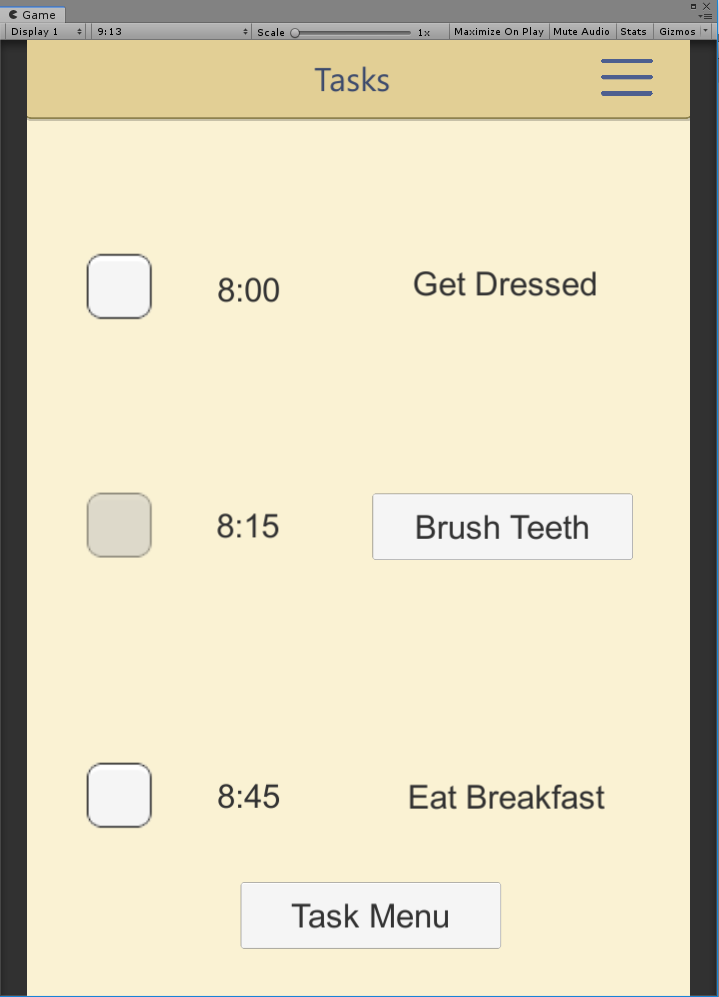The Issue
People with autism spectrum disorders (ASD) often find it difficult to complete daily activities that are less structured (National Institute of Mental Health, 2018). Task schedulers are tools that break up daily tasks into easy-to-follow steps that a user may reference to more easily complete an activity (Davies, 2015). Other tools that have been shown to reinforce learning in people with ASD can be paired with task schedulers, such as self-modeling. Self-modeling helps people with ASD learn various skills by using their own image in the educational material, and is successful with both video and still-images (Cihak, 2011).
My research built off these ideas and explored how digital aids like task schedulers could use self-modelling to increase engagement and a sense of self-determination in users with ASD by involving them in the process of their own skill acquisition. The application I developed through my research allows a hypothetical user to customize their task scheduler through the use of an avatar. Avatars are digital representations of an individuals that are often modified to suit the users preferences. Newbutt (2013) showed that users with ASD were able to create avatars, and see them as extensions of themselves, meaning there is potential in using avatars in self-modelling. Since I was not able to test the application on the target population, I focused on exploring and evaluating design elements that would be useful for users of different skill levels.
The Question
How can a digital application design, aimed at improving task initiation and completion, accommodate users across the autism spectrum by utilizing self-modelling with a user-designed avatar?
The Process






The main goal of the application structure was to implement design that could be used across the autism spectrum. However, the application could not be used in its entirety by many users on the autism spectrum who have high support needs. While the goal is that this application would help users with ASD gain more independence, the task scheduler by its nature has to include elements that may be difficult for some users with ASD to conceptualize, especially if they are in the population that is benefiting from having tasks broken up step by step with many supportive elements. Therefore, early conception of the application planned for two users.
Design elements included having large buttons and limiting complex motions, due to difficulties with fine motor control that people with ASD often experience (Quezada et al., 2017). Other UI development included limiting information per page when possible, clearly diving information where not, and giving options for pictures and words in the buttons of the Avatar Creation section.
The layout design was evaluated in iterations, first as a preliminary draft, and as a prototype:
Preliminary draft of Avatar Creation layout
Prototype Avatar Creation layout, with only 2 main categories
Preliminary draft of home page
Prototype home page, with changes in the button hiearchy
Preliminary draft task list
Prototype task list, using colors to differentiate areas of focus
Preliminary draft of one step in Task Completion
Prototype of one step in Task Completion.
The prototype also has elements that would be ideal in an application designed to help different skill sets, but were not part of the mechanics. The main example is the button in the image above for audio, which would be an option in a future iteration that allowed for a recording of the text prompt.
The Result
Video of the mechanics of the prototype:
The sections of the prototype that a user with ASD would need to be able to use with minimal aid, the Avatar Creation and Task Completion, were evaluated as useful for users both with high and low reading ability and technological literacy. Other sections of the application, such as task editing and changing profile settings, were evaluated as usable by users with ASD that had higher reading ability and technological literacy. There were areas where less information could have been shown, and some navigation issues to fix on future iterations of the application.
Sources
Cihak, D. F. (2011). Comparing pictorial and video modeling activity schedules during transitions for students with autism spectrum disorders. Research in Autism Spectrum Disorders, 5, 433-441. doi:10.1016/j.rasd.2010.06.006
Davies, C. (2015). Increasing independence in adults with autism spectrum disorders: Using a ‘to do’ list [Web page]. Retrieved from https://www.iidc.indiana.edu/pages/increasing-independence-in-adults
National Institute of Mental Health. (2018). Autism spectrum disorder [Fact Sheet]. Retrieved from https://www.nimh.nih.gov/health/topics/autism-spectrum-disorders-asd/index.shtml
Newbutt, N. A. (2013). Exploring communication and representation of the self in a virtual world by young people with autism (Doctoral dissertation). Retrieved from https://search.proquest.com/docview/1527127281
Quezada, A., Juárez-Ramírez, R., Jiménez, S., Noriega, A., Inzunza, S., & Garza, A. (2017). Usability operations on touch mobile devices for users with autism. Journal of Medical Systems, 41(11), 1-11. doi:10.1007/s10916-017-0827-z











